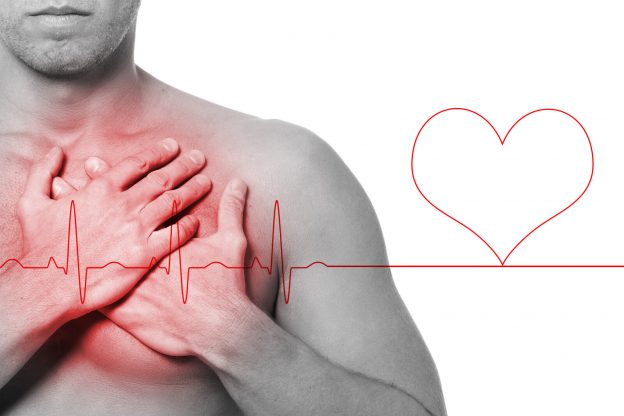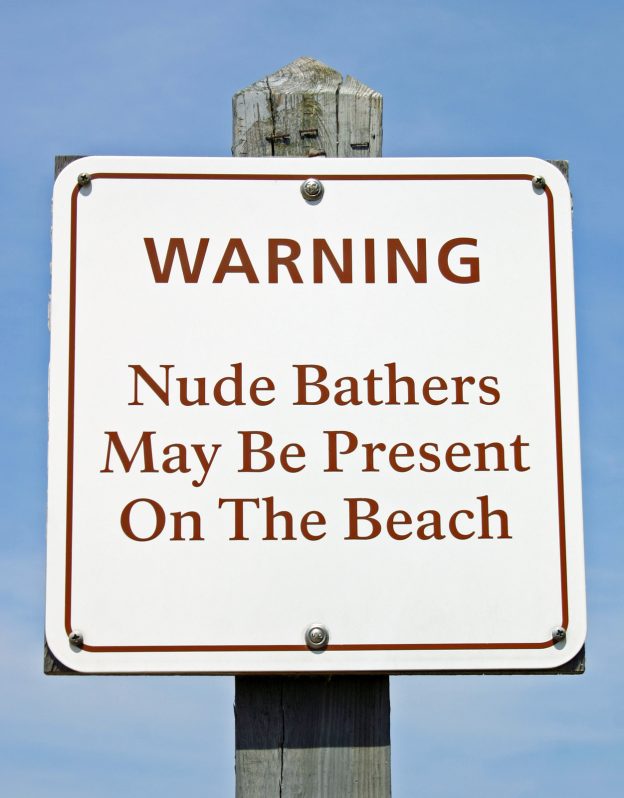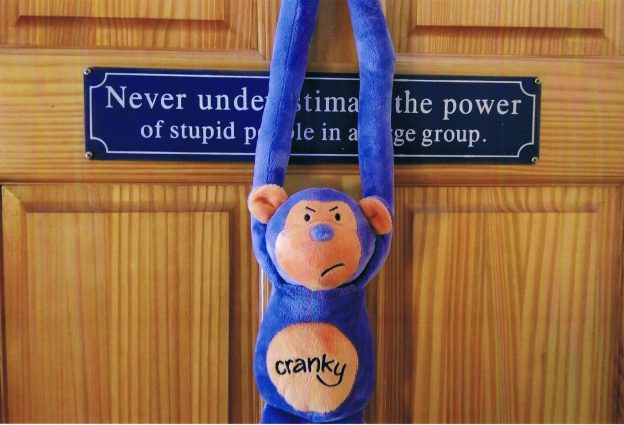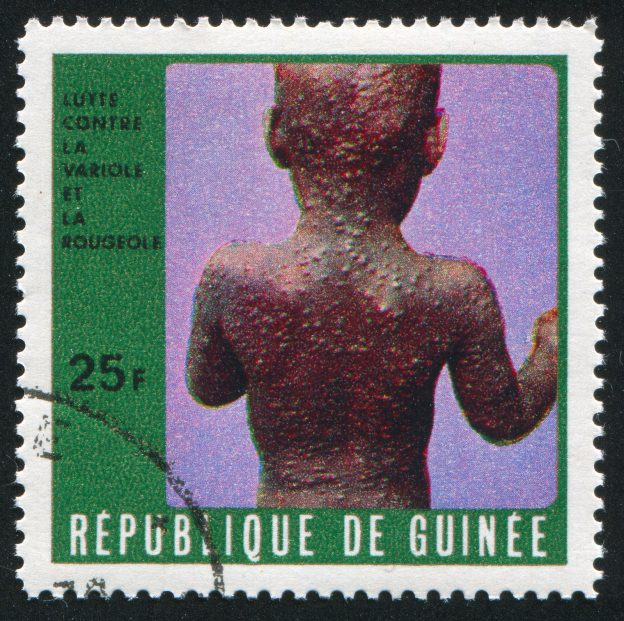Tuesday
One minute I’m sitting on the couch watching 911: Lone Star and the next we’re hauling ass down 22nd Street on our way to Our Lady of the Suburbs Hospital thinking I’m gonna die from a heart attack.
I’ve had one hell of a case of reflux from three decades of stress, heavy caffeine intake and being fat, so occasional epigastric “discomfort” doesn’t set off alarms. But this time the slight ache turned into a constant squeezing pressure just below my xiphoid, that triangular bone below your sternum (breastbone) and pain that ran up to my right jaw. I went to the dining room table and sat for about 10 minutes and, like every other guy facing the prospect of a life-altering illness, hoped it would go away.
It got worse.
Peg was on the phone with her sister when I said, “I need to go to the hospital right now!” I was clutching my chest and had that I’m-not-pulling-your-leg look.
“Oh, shit, I gotta go!” She hung up and asked, “Do you want me to call 9-1-1?”
Hell, no. My first and hopefully last ambulance trip cost about fifteen hundred bucks and we could get there faster by driving. We got into the car and for once Peg didn’t drive like my grandmother. We were at Highland Avenue in about five minutes; the hospital was another five minutes south.
I thought back to the time Peg’s mom Gloria took Michele’s husband to the same hospital with his second heart attack. She didn’t like the maniacal drivers on Highland and took the back way through Finley Square Mall. Despite being potentially on death’s door, Dave still had the presence of mind to backseat drive.
“This isn’t the way to go.”
Gloria snapped, “Well this is the way I go!”
Best not to piss off the woman who has your life in her hands.
Peg pulled into the circular drive at the Emergency Department entrance. I got out and slowly walked into the reception area, still clutching my chest. The pain wasn’t as bad, but it hadn’t gone away. Peg said, “Possible MI here!” which impressed no one behind the glass.
“Have you been here before?”
Does it fucking matter right now?
Peg whipped out the all-important insurance card while I grabbed the nearest wheelchair. A few minutes later someone came out to reception and wheeled me through the ED double doors. The desk clerk, whose duties include traffic control, said, “They’re just finishing cleaning up nine. You can take him in there in a couple of minutes.”
Even though I’ve done it a couple of times, I’m still not used to being the one being wheeled into an exam room. Usually, I’m the one strolling in after all the folderol is over and the patient is prepped. Now I’m the one climbing onto the gurney while a couple of people swarm around me like worker bees around the queen.
My shirt came off and someone put EKG leads on my chest, a blood pressure cuff on my left arm, a pulse oximeter on my left index finger, a thermometer under my tongue and an IV catheter in my right antecubital space (elbow joint), one of the worst places to put it. A lab tech took several tubes of blood before the nurse ran heparinized saline through the catheter before plugging the end. I put my gown on sometime during this onslaught. Someone else came in for a nasal swab for a COVID test.
A tech did an EKG and I figured I wasn’t having a cardiac issue since he didn’t go running down the hall for the crash cart team. Modern EKG machines print out a preliminary reading; mine was normal sinus rhythm. A radiology tech pulled a portable x-ray machine into the room, put a plate behind me and said, “Deep breath and hold it.” Imaging is all digital now; no more 55-gallon drums full of used x-ray film. The image appears on a computer monitor and the ability to zoom in and out means the radiologist doesn’t have to squint nearly as much.
The nurse started taking a history of my episode; this would be the first time of many that I’d recite the same story. This is not surprising since patients will tell nurses one thing and doctors something else. My story went like this:
“So, tell me what brought you to the hospital / what happened / what’s been going on?”
“I was sitting on the couch about a half hour after dinner and started to feel this pain right here (points to mid-epigastric area) that felt like someone was squeezing me really hard. I waited about ten minutes thinking it was going to get better, but it only got worse, so we came here.”
“When did it start?”
(Looking at the clock) “About 30 minutes ago.”
“Did the pain go anywhere else?” This is important because cardiac pain generally radiates to the left jaw and/or the left arm.
“It went up into my right jaw.”
“Any nausea, vomiting, sweating?” The first heart attack admission I saw when I was a 17-year-old hospital orderly was sweating like a pig*. Some have nausea and/or vomiting, making them think “it’s just a little indigestion.”
“How do you feel now?”
“Better than I did before I came here but it still hurts!”
*Before someone says, “Pigs don’t sweat,” that phrase came from iron smelting. Molten iron poured onto sand forms “pig iron” which resembles a sow and piglets. Moisture from the ambient air condenses onto the “pigs” as they cool, which looks like sweat. I didn’t know that before, and now you know it as well.
The nurse left and the ED physician, Dr. Nell, walked through the privacy curtain covering the exam room doorway. She was short and stocky with short blond hair peeking out from under her surgical cap; her last name suggested she was of Eastern European descent. She asked me “So, what happened?” (Go up two paragraphs for the recap.)
Before I answered I made a point of telling her I was a retired physician. Normally, I don’t advertise but I’ve found it comes in handy since physicians don’t treat their brethren with the same dismissive attitudes and skepticism reserved for the great unwashed.
She began her examination by listening to my heart and lungs, then pushed on my abdomen REALLY hard, like one of the old Soviet Union’s female weightlifters.
“AAAAAH!”
“Does this hurt?” Well, now it does!
She was quiet for a few minutes.
“You don’t have any of the classic heart attack signs like sweating or nausea and your EKG is normal, so it might be GI. I’m going to try nitroglycerine to see if it makes any difference while we’re waiting for your labs to come back.”
She left and a few minutes later the nurse returned with a small oval pill in a medicine cup.
“Put this under your tongue.”
Nitroglycerin is a vasodilator, a substance that relaxes smooth muscle and blood vessels, increasing blood flow to coronary arteries and is absorbed more rapidly from the mucous membrane under the tongue. The tablet itself irritating if left in one place too long and tastes like crap after disintegrating.
A few minutes passed and I didn’t feel any different. The pain had been slowly ebbing since I’d arrived, and my blood pressure dropped slightly. Dr. Nell returned.
“Did the nitro do anything?”
“No.”
“I didn’t think it would.”
“Yeah, neither did I.”
“Well, your troponin levels are stone cold negative, so I don’t think you’re having a heart attack.”
Troponins are proteins released into the blood when heart muscle is damaged. During my internship forty-some years ago we used to measure blood levels of lactate dehydrogenase (LDH) and creatine kinase (CK) when evaluating heart patients, but levels can be elevated with damage to other tissues. Troponins are much more specific.
She continued: “If it’s not cardiac, we start thinking of other causes, specifically gastrointestinal. Esophageal spasms (painful contractions of the esophagus) can mimic cardiac pain. We’ll have a GI evaluate you, but I want to try something else in the meantime. I’m going to give you a solution to drink.”
My nurse returned with a little turquoise container resembling a salad dressing packet, containing a solution of antacid and viscous lidocaine, a topical anesthetic. “We call this Magic Milk.”
I’m probably not going to like this, am I?
“It’s a combination of lidocaine and an antacid. You’re probably not going to like it.”
I’m used to downing Bicitra, something we gave to women before doing an emergency Cesarean section after a long, fruitless labor. It’s a solution of sodium citrate and citric acid with a fluorescent yellow-green appearance and tastes like thick, unsweetened Mountain Dew®. A friend of mine compared it to battery acid, but it cooled the burn expeditiously. It would probably be even better over ice with a little gin or vodka.
I tossed it back like a tequila shot, grimaced, and then roared, causing Peg to immediately panic.
“Are you OK??? Is something wrong???”
“Yeah, this stuff is really awful!”
Dr. Nell returned about 15 minutes later.
“Your labs are normal. Your EKG and chest x-ray are normal. I don’t know what’s causing the pain but it’s not likely cardiac. We’re going to keep you overnight and get consults in the morning.”
A woman from Admitting came in with a tablet and had me sign several forms, including “You’re responsible for any charges not covered by insurance. Don’t be a deadbeat or Vinnie will come visit you.” My nurse hooked me up to a telemetry EKG monitor. I got another wrist band and someone from transportation started pushing me down the hall.
I’ve seen friends and family in this hospital, so I knew my way around a bit, but that was walking upright. It’s almost impossible to know where you are looking at the ceiling, passing under fluorescent lights and acoustic tiles. Left, then right. Down one hallway, right and down another. A bell announced the elevator’s arrival; two bumps as the cart rode over the entrance.
A short trip up and I was on the 5th floor. The transportation dude wheeled me into the observation room.
“Can you make it to the bed?” Yeah, I’m not dead yet and I’m not as old as you think.
After I got settled I looked around at the luxury that was the observation room. I’d bet the Cook County jail had better holding cells.
There was a single hospital bed in what used to be a double room, a bedside table next to the bed, and a single utilitarian vinyl-upholstered recliner in the corner. A laptop was bolted to a mobile desktop between my bed and the bathroom wall. I think there was an unremarkable print on the wall, the kind whose eventual familiarity drives one insane. The walls were painted in either celery or baby diarrhea brown which, combined with the yellow tint of the fluorescent lighting, made the room even more dismal. The mattress was lumpy and about two inches thick; it alternately inflated and deflated in different spots, probably to prevent bedsores or blood clots in skinny, immobile old people. One could probably die from despair in here.
My nurse, Meghan, came in shortly to get me settled. She was tall with dark brown hair, grey eyes, not much of a butt and yes, I could be her father or grandfather. Just because I’m on a diet doesn’t mean I can’t look at the menu. What the hell else am I gonna do at 11:00 pm after thinking I was going to go to the Great Beyond?
We chatted a bit between the obligatory nursing documentation questions, including going through my medication list for the third or fourth time. Here’s a hint: if there are any meds you can do without for a few days before you get back home, don’t mention them. The hospital will give them to you while charging outlandish rates.
About 1am she came in and said, “Your lipase level came back 30,000 and the doctor thinks it might be pancreatitis, so we’re going to start I.V. fluids.” (Lipase is an enzyme the pancreas secretes to break down fats in one’s diet; an elevated level indicates inflammation from a number of causes, including alcoholism, gallstones or tumors.)
Pancreatitis? The only person I ever saw with pancreatitis was when I was a resident. She’d been deposited in our Labor Unit because some genius in the emergency room figured the woman in triage was (a) female and (b) in pain, so she must be in labor. She was actually 49 and had acute pancreatitis; and our nurse manager reamed someone a new one. I wasn’t in that much pain, but even I realized 30,000 was, if not an error, something terribly wrong.
Whoever gave the order also wanted me NPO, nil per os, meaning nothing to eat or drink. However, no one passed that on to me, so I kept drinking all night. And, not wanting to be a bother, I’d unplug the I.V. pump when I needed to urinate, wheel it to the bathroom, do my thing and hook it back up before getting back into bed, after figuring out how not to get tangle in the I.V. tubing. Two days passed and NO ONE asked why the bedside urinal was never used.
The bathroom was another disappointment. Commercial toilets are wall-mounted and, if done more than ten or twenty years ago, were lower to the ground than today’s “comfort height” toilets. Hospital toilets also have a rod connected to the plumbing that pulls down to spray out bedpans. Whoever does maintenance put in a six-inch lift between the bowl and the seat to raise the height but neglected to caulk the lower part of the lift. Anyone peeing sitting down (including me because it’s easier since my prostatectomy), ends up drenching the floor. It took a few trips to figure out why my feet were wet.
The lab took blood sometime during the night, but I wasn’t aware of it and figured they’d taken it out of the I.V. port. I wondered what fresh hell daylight would bring.
TO BE CONTINUED…
Featured image: Chest Pain. © Can Stock Photo / yekophotostudio




